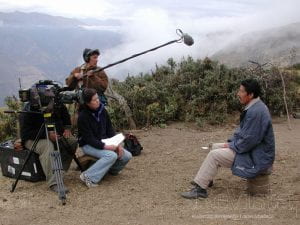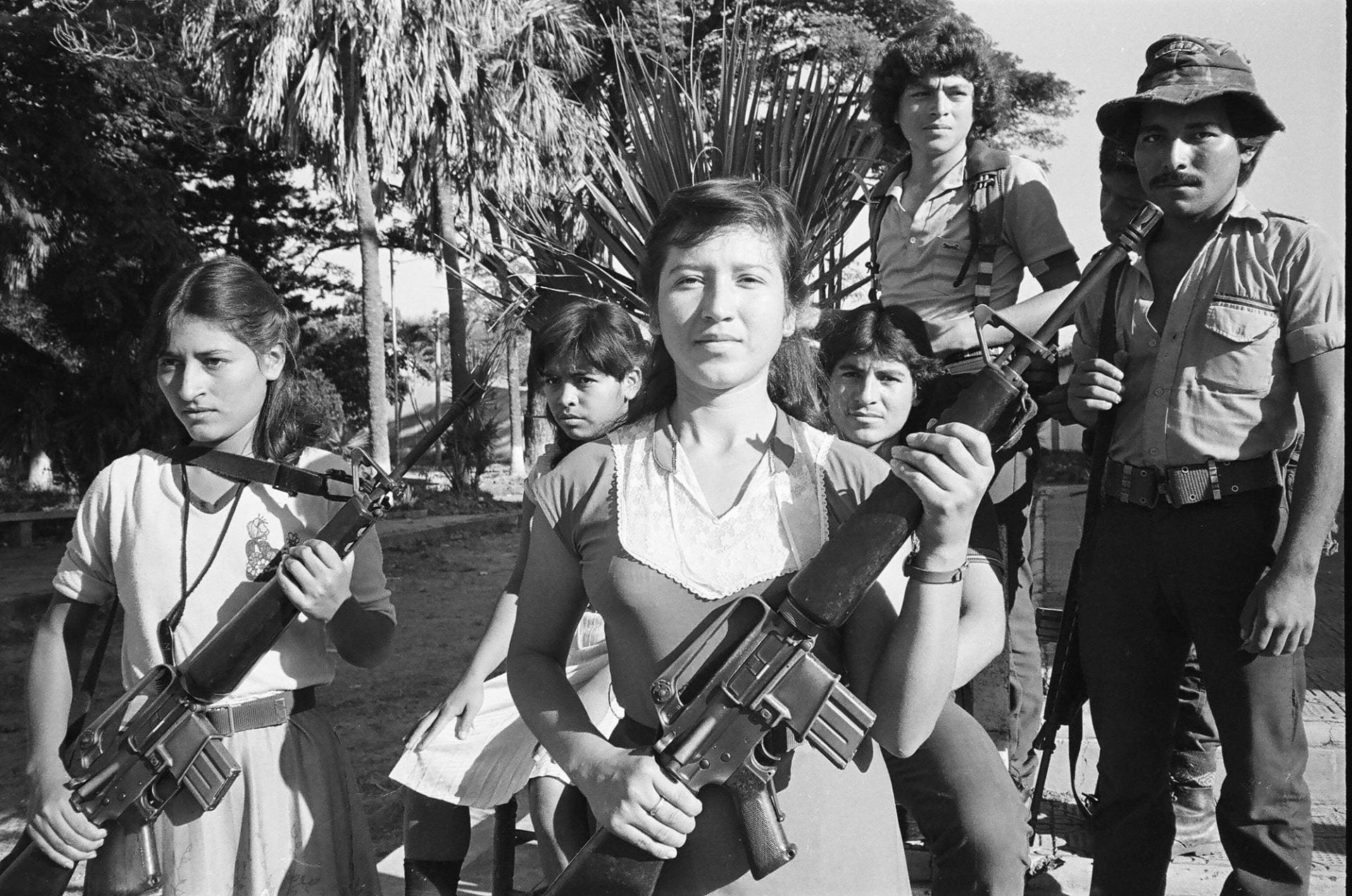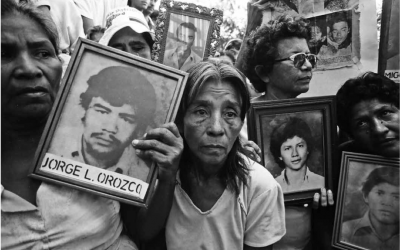Memoryscape
A Documentary Film Explores Memory

Pamela Yates filming in the Peruvian Andes with Ramiro Nino de Guzman for the State of Fear: The Truth About Terrorism. Photo by Vera Lentz
Walking up to 12,000 feet in the Peruvian Andes took two entire days. With Ramiro Niño de Guzmán, a Quechua-speaking human rights leader, I set out for his childhood home in Checcasa, along the same path that the army had taken when it attacked his village in 1988, accusing his family of being Shining Path insurgents. His brothers were tortured and killed, his sisters raped and dismembered. But this was 2006 and Ramiro and I were returning to Checcasa to show the villagers the documentary film he was featured in and that I had directed called State of Fear: The Truth About Terrorism. Ramiro wanted to have State of Fear create a village-wide dialogue about their memories of the war, and, steeped in that painful memory, have them demand action from the local government to provide promised reparations.
State of Fear is a film that looks backwards as well as forward. It tells the story of what the Peruvian Truth and Reconciliation Commission discovered about what had really happened during Peru’s 20-year war from 1980 to 2000. The Commission contested the official version that President Fujimori had promulgated, saying he had created economic prosperity and saved the country from terrorism. It replaced that narrative and rewrote that chapter of Peruvian history, giving voice to those most affected by the violence. The Commission’s findings indict both Shining Path and the government for the massive death toll. They called both for specific military members to be prosecuted, and for a change in the conditions of poverty and exclusion that set the stage for the rise of Shining Path.
My experience of being on the inside filming during the Truth Commission’s investigation inspired the making of a film about historical memory, now in pre-production, titled Memoryscape. Of course I would have to include Peru’s ongoing contested memory in this new documentary.
Our premise for the new film is that memory is fundamental to our humanity. For most of recorded time, history was written primarily by those in power to serve their own interests. Today, the establishment of historical memory is more likely to at least involve debate—and in the best cases negotiation—among competing groups and social forces. Indeed, a society’s shared memories are constructed under specific political circumstances. When different sectors of society have conflicting narratives and framing of past events, vested interests manipulate the present political environment to try to ensure that their version of events is accepted. In countries like Peru with violent and painful pasts, unresolved memory issues can have a toxic effect in the present—perpetuating a societal trauma that needs to find resolution.
Today we strive for a process of remembering that is increasingly democratic, collective, exciting and contested. When a nation engages in debate over how to memorialize its past in public spaces, the road to consensus is usually fraught with fiercely opposed points of view coming from all segments of society, from the heights of academia and state agencies to grassroots movements. In countries around the world, competing groups now have a voice—though often only through fierce struggle—in constructing the physical, narrative, and emotional landscape of shared memory. These memoryscapes—made up of elements ranging from memorials and museums to street signs—and the process of creating them are the subject of our film. A global trend is afoot with the evolution of historical memory into physical places embodied by sites of conscience and public memorials.
Memoryscape’s journey in Peru will focus on why a society must properly remember in order to progress—a process of consensus that seeks to integrate painful memories into a shared historical narrative. In Peru, despite an exhaustive truth commission and high visibility trials, entrenched political forces have made it extremely difficult for the country to properly bury its dead with the sacred rituals of remembering, to grieve deeply, to survive the pain and move forward.
Since the release of the Peruvian Truth and Reconciliation Commission’s Final Report in 2003, and its cinematic reflection in State of Fear, Peruvian society has been embroiled in a dramatic and often violent battle over how to understand and remember the 20-year “war on terror” with the Shining Path. Was ex-President Alberto Fujimori a hero who vanquished terrorism or a criminal who trampled human rights and used fear of terrorism to undermine democracy? Was it necessary to forfeit civil liberties to achieve security? Instead of definitively answering those questions, Fujimori’s recent trial, conviction, and sentence to 25 years in prison for human rights crimes has sparked a new wave of debate and polarization over Peru’s history.
In Lima, for example, some Fujimori supporters vandalized El Ojo Que Llora (The Eye That Cries), a memorial that seeks to commemorate a wide swath of those who died in the conflict—the military; government-backed citizen militias; imprisoned Shining Path insurgents; and civilians caught in the crossfire —in an effort to unite Peruvians. Yet the simple question of who is a victim and who is a perpetrator, who should be remembered and who deserves to be forgotten, remains contested and has wreaked havoc upon this memorial, bringing violence into a place intended for healing. It is a fraught political and moral controversy: for example, should the Shining Path prisoners who were killed extra-judicially by the governments of Alan García and Alberto Fujimori be named victims? Through interviews with Peruvians from across the political spectrum, Memoryscape will show how victims were not simply those killed by the Shining Path and armed forces, but the many people who continue to live, haunted by physical torture and psychological nightmares of the armed groups from two decades ago. Our film will dramatize how El Ojo Que Llora stands for the potential of a memorial to be a space for reflection and re-humanization, and how when such living memory is reconstructed individually and collectively, it can generate conditions for people to demand justice.
In the absence of a productive engagement with the past, the reemergence of the Shining Path under the Movimiento Por Amnistía y Derechos Fundamentales (MOVADEF) banner is possible. MOVADEF is a political movement made up of young people from the lower middle class who have attended university and are outraged by overwhelming economic inequality, lack of access to education, and other human rights abuses in Peru. These youths are saying that the brutality of Abimael Guzmán and Shining Path is a thing of the past, and are calling for an amnesty, thereby seeking to normalize the past by creating a narrative that says violence is part of what happens in war, and should simply be accepted. While MOVADEF is attempting to be a part of the political process by forming a political party, it has not renounced the nihilist ideology rooted in violence that guided the original emergence of Shining Path in 1980. Through interviews with these youth, Memoryscape will show the tragic myopia of historical memory in Peru. In a recent New York Times article, Francisco Soberón, executive director of Peru’s leading human rights organization Asociación Pro Derechos Humanos, described historical memory as a “vaccine” helping Peru to “prevent the rise of projects that can bring us back down that road of terror and violence.”
In conceiving Memoryscape, I recognize the inherent challenges and risks of drawing comparisons across very different places, yet am convinced that only a cross-cultural examination of this subject will reveal the essential human need to link together past, present, and future. Our overarching goal in the film is to tell a universal story while illuminating the specific histories and cultural contexts in Peru (contested memory), Spain (repressed memory), Germany (embedded memory) and the United States (mythologized memory).
The visual storytelling in Memoryscape will come from a place of profound contemplation. The combination of innovative actors that motivate the modern memory movement, and poetic cinematography that describes the panorama of different experiences, will try to inspire new thinking in the viewers’ consciousness. Our trajectory as human rights filmmakers will build the narrative on the notion that truth, memory and justice must powerfully work together.
Moving through time and space, Memoryscape will evoke the profound emotions associated with memory: fear, anger, grief, nostalgia and reverie. Viewers will be part of a journey of discovery through architectural spaces, sites of conscience, monuments, and public art works that can illuminate historical and collective memory. At times I will employ a straightforward chronological approach mirroring the linear and mechanical way of how memory is constructed, with each unique event triggering the next. At other times the presentation of images will represent a very different understanding of the structure of memory, as when past events burst into a person’s present life reflecting a moment when we experience the importance of remembering as an engine for decision-making in the present. Finally, there will be sequences that are more of a reflection of our memory that has no boundary of time, so that the events of one period may be examined in tandem with those of a much different historic moment.
Viewers will engage with our shared humanity at the core of each story through the people we follow who play essential roles in the film. For example, in Peru we will weave together the stories of indigenous Andean villagers, Fujimori supporters and family members of those killed by the Shining Path, individual artists creating memoryscapes, youths in the MOVADEF movement, and commissioners of Peru’s Truth Commission.
A hallmark of all my films is the understanding that the geography in the closeup of the human face is the most beautiful panorama of cinema. We connect visually with the eyes on the screen, and the emotion and memory connected to our limbic brain kick in.
Film is also unique in its ability to explore the dimension of time with the non-linear nature and construction of memory. Legendary Russian Director Andrei Tarkovsky considered filmmaking to be “sculpting in time.” The ability to expand and compress time in the film medium makes it a perfect vehicle for the exploration of historical memory. Memoryscape will be a part of the modern movement to reflect historic memory in physical spaces, bringing the audience into an intellectual and emotional relationship with contested issues. In this way, we will stimulate the desire to be part of the quest to make historical memory an integral component of human rights and the quest for democracy.
Pamela Yates is a documentary film director and co-founder of Skylight. Her film State of Fear was translated into 47 languages and broadcast in 154 countries. Her latest film is Granito: How to Nail a Dictator. She is now working on the sequel 500 Years, about the Ríos Montt genocide trial.
Related Articles
A Search for Justice
In 2004, when I left Harvard and last saw you, I thought I would never learn the truth of what exactly happened to Carlos Horacio in the horrendous holocaust of the Palace of Justice in Bogotá. Yet fate was holding a tremendous surprise for my daughters and me, filled with…
Memory: Editor’s Letter
Editor's Letter Memory Irma Flaquer’s image as a 22-year-old Guatemalan reporter stares from the pages of a 1960 Time magazine, her eyes blackened by a government mob that didn’t like her feisty stance. She never gave up, fighting with her pen against the long...
A Search for Justice in El Salvador: One Legacy of Ignacio Martín-Baró
In the small rural town of Arcatao, Chalatenango, Rosa Rivera clung to the hope that one day she would find the remains of her disappeared mother and father and lay them to rest in peace. Others sought to exhume mass graves hoping to recover bodies of nearly 1,000 relatives massacred in the Río Sumpul. …




